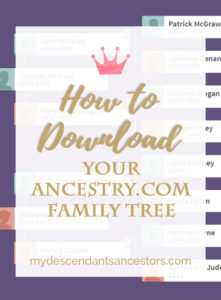- How Do I Download Gedcom From Ancestry
- Create A Gedcom From Ancestry
- How To Download Ancestry Tree
- How To Download A Ged.com From Ancestry

Feb 22, 2019 - To download a GEDCOM file, make sure you are logged in to Geni. (excludes adopted relatives);; Ancestors - parents, their parents, etc. As noted above, you’ll need to download larger albums in chunks. I copied them in batches of 50-60 photos to “new” albums, then downloaded those smaller albums. The photos inside the GEDCOM file are the issue. Although there is an option to download the individual photos along with the GEDCOM file, my export didn’t contain them.
If you have created a family tree at Ancestry.com, they have instructions on their site on how to download a GEDCOM. See the answer below. May 26, 2015 - Here's how to download your Ancestry.com tree. Step 4: When the GEDCOM is finished compiling, click the “Download Your GEDCOM File”. Opening a GEDCOM file is usually straightforward. Begin by ensuring that the file is truly a genealogy GEDCOM file and not a family tree file created in some proprietary format by a genealogy software program. A file is in GEDCOM format when it ends in the extension.ged.
I know someone who has a PAF file he wants to use but can no longer access because Personal Ancestral File is gone from his computer. It's been discontinued, so he needs to move to something else and import the PAF file.
How Do I Download Gedcom From Ancestry

Is there a free and open source way of converting PAF to GEDCOM? I would like to help by converting the file and getting away from that proprietary format but without getting into commercial software or crosswalking through another proprietary format if possible.
3 Answers
There are two ways of doing this that I can think of:
- Use the free version of Ancestral Quest Basics available from here. It is written by the authors of PAF and allows PAF import and Gedcom export.
- Download PAF from one of the sites that still has it available for download such as this one
If you don't mind it being online temporarily, you could simply upload it to ancestry.com as a private tree (make it unindexed also). Then download it as a GEDCOM (and delete it from ancestry). This isn't as cumbersome as it sounds!
PAF v5.2 is available at:
links at top right of Page.
also checkout Answer #1.
Not the answer you're looking for? Browse other questions tagged gedcomsoftware-recommendations or ask your own question.

You’ve seen it mentioned on your favorite Web sites and in practically every issue of this magazine. Thousands of family historians use it to save and swap their data. But for many roots researchers, it’s one of genealogy’s enduring mysteries.
We’re talking about GEDCOM, of course—that ubiquitous acronym for GEnealogical Data COMmunications, the standard computer file format family historians use to exchange information. Though most people have little trouble using their genealogy software to enter data and print reports, handling GEDCOMs can be intimidating. Fear not: Our primer provides step-by-step instructions for creating and using GEDCOM files.
GEDCOM basics
We’ve explained what GEDCOM stands for—but what does it mean for your family history research?
If you think of computer file formats as languages, GEDCOM is the one that all genealogy software “speaks.” Each family tree program has its own default file format (called a proprietary format), which other software usually can’t “translate.” But every program can read and write GEDCOM files, too.
That means you can share your family information with your relatives, even if you use different programs. You also can contribute your work to online databases such as FamilySearch Memories, or download a fellow researcher’s data and add it to your own family file—without retyping anything.
The catch: Because those proprietary formats treat information differently than GEDCOM does, data doesn’t transfer perfectly. Some genealogy programs read Family Tree Maker (FTM), Personal Ancestral File (PAF) and other file formats directly—no GEDCOM conversion required. That can save time and produce more accurate results, so see if your software offers this option before using a GEDCOM file.
Important pointers
Opening a GEDCOM file is simple. In Windows, just double-click on the file (GEDCOMs have the file extension .ged, as in smith.ged), and it should open with your genealogy software. Accept the default file name and location, and your program will “import” the file—basically, it creates a copy of the GEDCOM file in your software’s proprietary format.
That’s the quickest method, but you’ll get better results with a little extra effort. Just follow these steps:
1. Locate the file. Once you’ve downloaded a GEDCOM file or received one as an e-mail attachment, note its location on your computer’s hard drive or removable drive. You might want to save all your GEDCOM files in a folder named GEDCOM.
2. “Stamp” the records. RootsMagic and Legacy Family Tree let you add a source (a person’s name, address and e-mail address) to each fact in an incoming GEDCOM file so you know where the information came from. If you use a different program, Progeny Software’s GEDmark ($9.95 download or $14.95 on CD) can mark the source information on each record in the GEDCOM file before you import it into your family file.
3. Select the file. Start your genealogy software and select File>Import File. Locate and select the GEDCOM file, then click OK.
Create A Gedcom From Ancestry
4. Import the file. Most programs will now ask you if you want to add the data to your existing file or create a new one. We recommend viewing the new data in a separate file before adding it to your existing family file.
5. Link the multimedia files. If the GEDCOM’s creator attached pictures, sound or video, you’ll have an extra step: Copy the picture files to your computer and make sure the links in your new family file still point to the pictures. Suppose the sender kept the images on drive C in a folder called Genealogy Pictures within the My Pictures folder. The links should work if you keep the pictures in an identically named folder at the same location.
If you click on a link to a picture in PAF and it can’t find the image, the program will prompt you to locate the file. Then it will ask if you want to change the paths to all the multimedia links in the file to the new path you specified. Answer “yes.” As long as you kept all the images in the same folder, the links will be updated correctly.
Family Tree Maker’s GEDCOMs don’t include multimedia links, and FTM can’t import the multimedia links in GEDCOM files created with other programs. But FTM does store multimedia files—not just links—within its own format. So if you’re sharing a file with another FTM user, it’s better to exchange FTM files, not GEDCOMs.
6. Merge duplicate records. If you import data to an existing family file, it’s important to merge duplicates. The same person might appear twice, with one record linked to his ancestors and one linked to his descendants. Most programs can identify potential matches and merge them automatically or manually.
Outbound training
Now that you know how to import GEDCOMs, it’s time to share them with others. Simply use the process below and you’ll be swapping files in a flash.
1. Pick people. After choosing File>Export, select which individuals to include in the GEDCOM file. You might choose specific people, families, ancestors or descendants.
2. Select from the options. Should the GEDCOM file include notes and sources? They’re important, unless you’ll use the file just to create a wall chart. Should it include multimedia links? That’s a good idea, unless you’re submitting the file to a pedigree database, which can’t accept multimedia anyway.
How To Download Ancestry Tree
3. Leave your mark. Once you share a GEDCOM file, it’ll probably get passed on to other researchers—before you know it, your data could appear all over the Internet. Be sure to “stamp” your name and contact information on each record using GEDmark, so people know how to reach you (see step 2).
4. Copy the multimedia files. Don’t forget to send your multimedia files with the GEDCOM file, along with a note giving the files’ location on your computer.
How To Download A Ged.com From Ancestry
See? GEDCOMs aren’t really that mystifying, after all. Once you’ve mastered these steps, you’ll become a GEDCOM guru—and be able to concentrate on solving your enduring research mysteries.